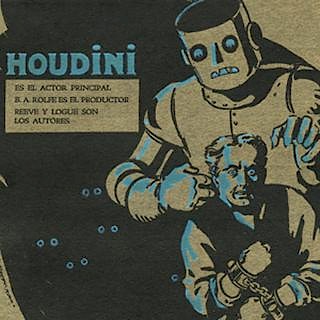Bess Houdini's Diamond and Gemstone Brooch
Lot 290
Categories
Estimate:
$30,000 - $40,000
Absentee vs Live bid
Two ways to bid:
- Leave a max absentee bid and the platform will bid on your behalf up to your maximum bid during the live auction.
- Bid live during the auction and your bids will be submitted real-time to the auctioneer.
Bid Increments
| Price | Bid Increment |
|---|---|
| $0 | $5 |
| $30 | $10 |
| $100 | $25 |
| $500 | $50 |
| $1,000 | $100 |
| $2,000 | $200 |
| $6,000 | $500 |
| $10,000 | $1,000 |
| $20,000 | $2,000 |
| $50,000 | $5,000 |
| $100,000 | $10,000 |
About Auction
By Potter & Potter Auctions
Apr 8, 2017 - Apr 9, 2017
Set Reminder
2017-04-08 11:00:00
2017-04-09 11:00:00
America/New_York
Bidsquare
Bidsquare : Spring Magic Auction
https://www.bidsquare.com/auctions/potter-potter/spring-magic-auction-2200
Potter & Potter Auctions potterauctions@gmail.com
Potter & Potter Auctions potterauctions@gmail.com
- Lot Description
Houdini, Beatrice and Harry. Royal Crown Brooch Owned and Worn by Bess Houdini, A Gift from Russian Royalty Circa 1903. A gorgeous 14k gold crown outline, encrusted with 39 old mine diamonds, 17 round sapphires, 14 round rubies, and a single emerald. Four 4mm rubies set six prong. On a 19” gold twist chain (1.25mm). Brooch 29mm x 39mm. One of the most well-documented personal artifacts from the Houdinis to appear in recent memory, studio photographs depict Bess donning the piece both soon after she obtained it and decades later, following Harry’s death. Clearly an object of great value to her, she presented the brooch as a gift to her close friend Geraldine Larsen, with whom, in 1939, she formed Magigals, an organization for female magicians. The organization’s top prize at its annual awards banquet became the “Houdini Award” – a pin modeled in part after this very piece. In all the intervening years, the piece has remained in the Larsens’ collection. While Bess’s ownership of the brooch is firmly documented, the question as from whom it was originally a gift is more difficult to pinpoint, but it seems highly likely to have come from the highest ranks of Russian royalty, if not from Tsar Nicholas II himself. Bess, accompanying Harry on his 1903 Russian tour, performed together with him privately for the Grand Duke Sergei Aleksandrovich and his wife, the Grand Duchess Elisabeth of Hesse and Rhine. Houdini chronicled this relationship in his magazine, Conjurers’ Monthly, writing that his friendliness with the duke “helped to make a name for me in Russia.” (Dec. 1906, p. 131). Multiple biographical accounts of the encounters state that the royal family, thrilled by the Houdinis’ magical abilities, awarded them numerous valuable gifts, a customary gesture at such command performances (see Silverman, Houdini!!! Life of Ehrich Weiss (1996, p. 101); and Kalush and Sloman, Secret Life of Houdini (2006, p. 139). The prizes were said to include a champagne ladle, jewelry, and even the couple’s beloved Pomeranian dog “Charlie.” The brooch may have been among the pieces of jewelry presented by the duke and duchess, but others have placed the Houdinis in the presence of the tsar, where a similar type of presentation might have occurred. In these accounts, one as told by Orson Welles, Houdini, having been recommended by the duke, amazed the tsar by causing the bells of the Kremlin to ring for the first time in more than a century, and later turned down the tsar’s offer to act as his “spiritual advisor.” But Houdini never recorded such a story himself. By way of opposing estimation, one might look to Houdini’s own remarks on the Russian magician Robert Lenz, who had claimed he and his wife (Roberta) received a diamond watch and brooch from the tsar, and who jealously proclaimed that he had introduced the type of trunk mystery Houdini was then using in Russia some thirty years earlier: “Of all the false representations, and schemes for obtaining money, under false pretense, ‘Roberta the Celebrated’ took the bun, biscuit, and bake shop.”
- Shipping Info
-
If your bid is successful, as an alternative to in-house shipping, we can provide you with a list of shippers. We will not be responsible for the acts or omissions of carriers or packers whether or not recommended by us. Property will not be released to the shipper without the buyer's written consent and until payment has been made in full. Packing and handling by us of purchased lots is at the entire risk of the purchaser, and Potter and Potter Auctions, Inc. will have no liability of any loss or damage to such items. Packing and shipping expenses shall be added to buyer's invoice and will reflect a charge for labor, materials, insurance, transportation, as well as actual shipper fees.
-
- Buyer's Premium



 EUR
EUR CAD
CAD AUD
AUD GBP
GBP MXN
MXN HKD
HKD CNY
CNY MYR
MYR SEK
SEK SGD
SGD CHF
CHF THB
THB












